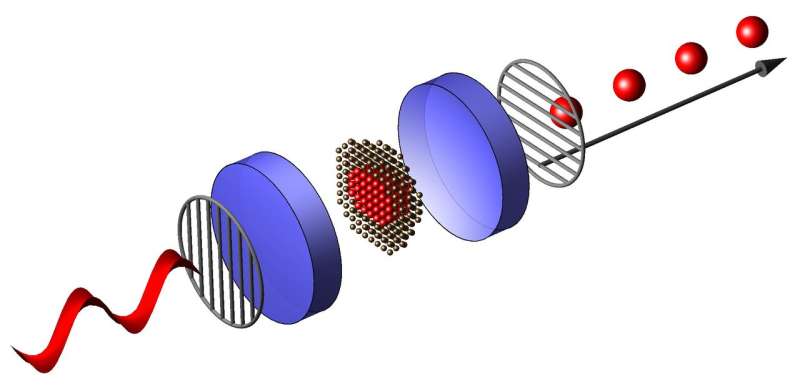糖心视频icists demonstrate new method to make single photons

Scientists need individual photons for quantum cryptography and quantum computers. Leiden physicists have now experimentally demonstrated a new production method. Publication in 糖心视频ical Review Letters on July 23rd.
When we talk to each other, we use a wide range of communication tools. We shout or whisper, use a high or low voice and speak slowly or quickly. Light is also a rich source of information. It can vary in color, intensity, polarization and short or long flashes. Light usually consists of countless particles鈥� photons. But if you use single photons, you gain access to a hidden level of information. Quantum phenomena will occur, such as spin and entanglement, making it possible to communicate in perfect secrecy, or to solve complicated mathematical problems with quantum computers. However, producing individual photons is not trivial. Scientists are looking for ways to do that as easily as possible. The quantum optics group at Leiden University has now experimentally demonstrated a new method.
糖心视频icists create single photons as follows: A laser shines on a large artificial atom鈥攁 quantum dot鈥攊nside an optical cavity. The cavity captures the laser light, which continues to bounce around until it hits the quantum dot. Within the quantum dot an electron gets excited, after which it falls back to its original energy level, emitting a single photon. Mission accomplished. But, making such a true "single photon turnstile," where the underlying phenomenon is called "photon blockade," is very hard because any residual laser light will spoil the single photons.
Leiden researchers have now provided experimental evidence for a different way to produce single photons. Co-authors Vincenzo Savona and Hugo Flayac from EPFL Lausanne came up with the theory for this. In this method鈥攃alled unconventional photon blockade鈥攖he quantum dot within the cavity is excited by light of a certain polarization. Quantum interference then provides a beam of individual photons. "Our method works through a fundamentally different physical mechanism," says lead author Henk Snijders. "That makes this an interesting discovery."
More information: H.J. Snijders, J. A. Frey, J. Norman, H. Flayac, V. Savona, A. C. Gossard, J. E. Bowers, M. P. van Exter, D. Bouwmeester, W. L枚ffler, 'Single photons and unconventional photon blockade in quantum dot cavity-QED', 糖心视频ical Review Letters.
Journal information: 糖心视频ical Review Letters
Provided by Leiden Institute of 糖心视频ics




















